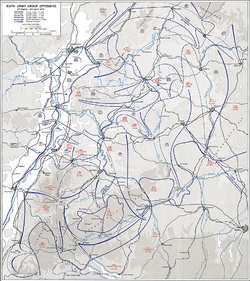Battle of Heilbronn (1945)
| Battle of Heilbronn | |||||||
|---|---|---|---|---|---|---|---|
| Part of World War II | |||||||
 Allied Sixth Army Group Offensive, March–April 1945 |
|||||||
|
|||||||
| Belligerents | |||||||
|
|
|
||||||
| Commanders and leaders | |||||||
|
|
|
||||||
| Units involved | |||||||
| U.S. VI Corps | German XIII Corps | ||||||
| Casualties and losses | |||||||
| 60 KIA, 250 WIA, and 112 MIA (100th Division) | 1,500 POW as well as others killed and wounded | ||||||
The Battle of Heilbronn was a nine-day struggle in April 1945 during World War II between the United States Army and the German Army for the control of Heilbronn, a mid-sized city on the Neckar River located between Stuttgart and Heidelberg. Despite the impending end of the war, the battle was characterized by very firm German resistance and the presence of various Nazi Party auxiliaries among the regular German troops. Following days of house-to-house combat, troops of the U.S. 100th Infantry Division captured Heilbronn and the U.S. VI Corps continued its march to the southeast.
Presence of the First Army’s only remaining battleworthy division, the 17th SS Panzer Grenadier, plus imposing river obstacles, gave real substance to the new German line along the Jagst-Neckar crescent. In addition, the First Army commander General Foertsch had managed through prodigious efforts to accumulate a sizable conglomeration of other troops—two battalions of an engineer school, several regular engineer battalions, replacement artillery and antiaircraft units, Volkssturm, a few tanks and assault guns, and a miscellany, including several hundred Hitler Youth, belonging to the combat commander of Heilbronn. These troops and remnants of four divisions, plus the panzer grenadiers, were all subordinated to General Bork’sXIII Corps. Loose ends of two other divisions, including the 2d Mountain Division, were positioned on the north wing of Beyer’s LXXX Corps and thus might be used to help defend Heilbronn.
...
Wikipedia
